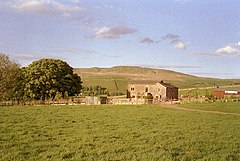Stainmore
- For other uses of Stainmore see Stainmore (disambiguation)
| Stainmore | |
|---|---|
 Mousegill, with Great Knipe behind | |
| Population | 253 (2001) |
| OS grid reference | NY8314 |
| Civil parish |
|
| District | |
| Shire county | |
| Region | |
| Country | England |
| Sovereign state | United Kingdom |
| Post town | KIRKBY STEPHEN |
| Postcode district | CA17 |
| Dialling code | 01768 |
| Police | Cumbria |
| Fire | Cumbria |
| Ambulance | North West |
| UK Parliament | |
Stainmore is a remote geographic area in the Pennines on the border of Cumbria, County Durham and North Yorkshire.[1][2] The name is used for a civil parish in the Eden District of Cumbria, England, including the villages of North Stainmore and South Stainmore. The parish has a population of 253.[3]
Geography
Stainmore is drained by the River Belah and the River Balder. It is crossed by the Roman road from Bowes to Brough, now part of the A66, and formerly by the Stainmore Railway. Each of these lines of communication has made use of the relatively low broad saddle between the higher hills to north and south which is commonly referred to as the Stainmore Gap. The summit of the former railway is around 420 metres (1,380 ft) above sea level, though the roads climb to slightly higher elevations.[4] The Gap is coincident with the Stainmore Summit Fault which throws the relatively flat-lying Carboniferous rocks of the area down to the south.[5] It acted as a conduit for Lake District-originated ice to pass eastwards during one or more glacial periods. There are several RIGS sites in the Stainmore area.
History
According to Roger of Wendover, it was where Eric Bloodaxe (d. 954), recently expelled from York, was betrayed and killed, an event which some historians believe to have taken place in a great battle.[6] Ancient monuments include a Roman marching camp at Rey Cross (54°30′25″N 2°09′19″W / 54.5070°N 2.1552°W), and the Rey Cross itself (54°30′21″N 2°08′55″W / 54.50579°N 2.14867°W), also called Rere Cross (Scheduled monument, no. 32713).[7]
References
- ^ "Local History: Stainmore (County Durham)". County Councils of Northumberland and Durham. 11 September 2012. Retrieved 14 September 2013.
- ^ Pearsall, W.H. (1941). "The "Mosses" of the Stainmore district". Journal of Ecology. 29 (1). Retrieved 14 September 2013.
- ^ "Census 2001 : Parish Headcounts : Eden". Office for National Statistics. n.d. Retrieved 26 October 2010.
- ^ Ordnance Survey 1:25,000 scale Explorer map sheet OL19 Howgill Fells & Upper Eden Valley
- ^ British Geological Survey 1:50,000 scale geological map sheet no 31 (England & Wales) Brough-under-Stainmore
- ^ Roger of Wendover's Flowers of History, Comprising the History of England from the Descent of the Saxons to A. D. 1235 Formerly Ascribed to Matthew Paris, trans. by J. A. Giles, 2 vols (London: Bohn, 1849), I, 256 (s.a. 950) http://archive.org/details/rogerofwendovers01rogemiss.
- ^ Rey Cross Roman Marching Camp
Further reading
- Collingwood, W.G. "Rey-Cross." Transactions of the Cumberland and Westmorland Antiquarian Archaeological Society series 2, 27 (1927): 1–10.
- Ramsden, D.M. From Stainmore to the Tees. Clapham, 1948.
- Richmond, I.A. and McIntyre, J. "The Roman marching camps at Reycross and Crackenthorpe." Transactions of the Cumberland and Westmorland Antiquarian Archaeological Society series 2, 34 (1934): 50–61.
- Robinson, P. Archaeology on the Stainmore Pass – the A66 Project. Barnard Castle, 1993.
- Vyner, B. (ed.). Stainmore. The Archaeology of a North Pennine Pass. Tees Archaeology Monographs 1. Hartlepool, 2001.
